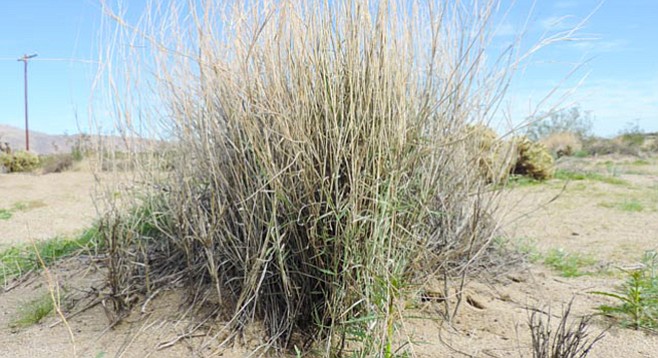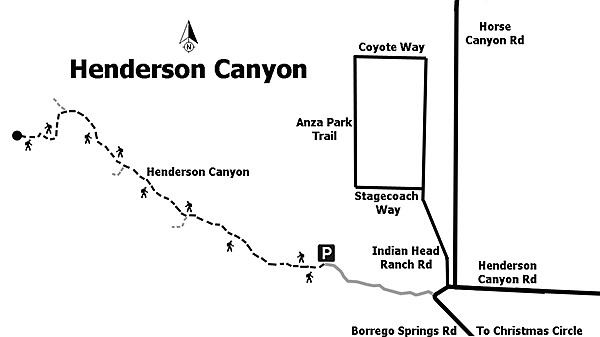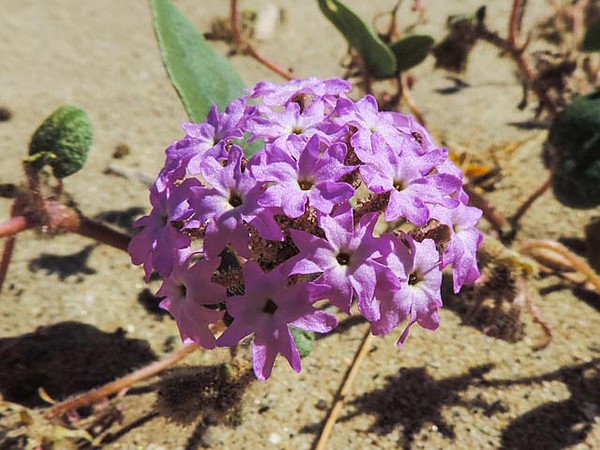 Facebook
Facebook
 X
X
 Instagram
Instagram
 TikTok
TikTok
 Youtube
Youtube

While Henderson Canyon lies just a few miles north of the very popular and often visited Hellhole and Borrego Palm canyons, it sees less activity and is a pleasant alternative for those wishing to avoid the weekend crowds. Although lacking the abundant water of its neighboring canyons, which accounts for the absence of our native California palm trees, the spring wildflower displays can be even more spectacular here. The origin of the name Henderson Canyon is not clear. It may have been named after the founder and publisher of Desert Magazine, Randall Henderson, who explored many of the local canyons in his search for palm oases. Another possibility is that it was named after an old miner who once had his cabin in the canyon. At one time this canyon may have also been known as Sheep Canyon, but that name now belongs to another canyon several miles further north in the Coyote Canyon area.

From the junction of Borrego Springs Rd. and Henderson Canyon Rd. turn left onto the dirt road marked by a metal sculpture of a Jeep, modeled after a late 1940s Willys Jeep CJ, as it climbs forever upward over a rocky road. This is just one of over 130 amazing sculptures created by artist Ricardo Breceda that are found in and around Borrego Springs. This area is known as Galleta Meadows, named after the galleta grass found here. This native grass was once an important food source for livestock that foraged in and around Borrego Springs. Galleta grass grows in clumps that can be several feet wide and over one foot in height. Its clumping growth form prevented it from being trampled when it was grazed. In the spring this is a good place to look for the low-growing pinkish purple flowers of desert sand verbena. The months of March and April mark the return of the Swainson’s hawks to Anza-Borrego. Look up above the ridgeline and you may spot a kettle (a large group of hawks swirling around in the shape of a kettle) as they ride the thermals over the valley.

You now have the choice to either continue driving or leaving your vehicle by the Jeep sculpture and starting your hike at this point. While 4WD is normally unnecessary, the road can be rocky in places and high clearance may be desirable. The gated entrance to the road seems to be open throughout most of the year. If, however, the gate is locked, please respect the property owner’s wishes and don’t enter the road. Beginning your walk from here will extend your hike by 2 miles. Either by foot or vehicle, head about 100 yards toward the sculpture of a monk, said to be the Spanish padre Pedro Font and his dog, and then on to the sculpture of a saguaro cactus. Continue to follow the dirt road that runs in front of these sculptures westward for approximately 1 mile until it ends. Now on foot, continue heading in a northwesterly direction toward the mouth of the canyon. If you are visiting in the spring, be sure to keep your eyes open for many different types of desert wildflowers that grow among the rocks and in the washes. There may be some indications of a trail, but in general you’ll be finding your own path. Be sure to carefully note your route so you will be able to retrace your steps. Continue in the northwest direction once in the main wash. At about 1.25 miles and again at 1.75 miles into your hike you’ll note canyons leading off to the left. Pass these by and continue up the main canyon. At about 2.5 miles, bear left to stay in the wash. At this point the trail becomes progressively more rocky and eventually requires boulder-scrambling so continue as desired though remember to check if you have enough water and energy. At about 3 miles there is a dry waterfall that makes a good turnaround point. Follow the same general path back to reach your vehicle.
Distance from downtown San Diego: Approximately 90 miles. Allow 2 hours driving time (Borrego Springs). From Ramona, drive east on SR-78 to Santa Ysabel. Turn north on SR-79 and drive to the junction with SR-2/San Felipe Road and turn southeast. At the junction with SR-22, turn east to Ranchita and follow SR-22 to the stop sign in Borrego Springs. Turn right and at the traffic circle go ¾ of the way around and exit onto Borrego Springs Rd. going north. Go 3.5 miles to the junction of Henderson Canyon Road.
Hiking length: 6 miles out and back.
Difficulty: Starts out easy but increases in difficulty to moderate with about 800 feet of elevation gain/loss. After the first half-mile there is no marked trail. Some boulder-scrambling may be required for the last half-mile. There are no facilities or water at the trailhead but both can be found at Christmas Circle.


While Henderson Canyon lies just a few miles north of the very popular and often visited Hellhole and Borrego Palm canyons, it sees less activity and is a pleasant alternative for those wishing to avoid the weekend crowds. Although lacking the abundant water of its neighboring canyons, which accounts for the absence of our native California palm trees, the spring wildflower displays can be even more spectacular here. The origin of the name Henderson Canyon is not clear. It may have been named after the founder and publisher of Desert Magazine, Randall Henderson, who explored many of the local canyons in his search for palm oases. Another possibility is that it was named after an old miner who once had his cabin in the canyon. At one time this canyon may have also been known as Sheep Canyon, but that name now belongs to another canyon several miles further north in the Coyote Canyon area.

From the junction of Borrego Springs Rd. and Henderson Canyon Rd. turn left onto the dirt road marked by a metal sculpture of a Jeep, modeled after a late 1940s Willys Jeep CJ, as it climbs forever upward over a rocky road. This is just one of over 130 amazing sculptures created by artist Ricardo Breceda that are found in and around Borrego Springs. This area is known as Galleta Meadows, named after the galleta grass found here. This native grass was once an important food source for livestock that foraged in and around Borrego Springs. Galleta grass grows in clumps that can be several feet wide and over one foot in height. Its clumping growth form prevented it from being trampled when it was grazed. In the spring this is a good place to look for the low-growing pinkish purple flowers of desert sand verbena. The months of March and April mark the return of the Swainson’s hawks to Anza-Borrego. Look up above the ridgeline and you may spot a kettle (a large group of hawks swirling around in the shape of a kettle) as they ride the thermals over the valley.

You now have the choice to either continue driving or leaving your vehicle by the Jeep sculpture and starting your hike at this point. While 4WD is normally unnecessary, the road can be rocky in places and high clearance may be desirable. The gated entrance to the road seems to be open throughout most of the year. If, however, the gate is locked, please respect the property owner’s wishes and don’t enter the road. Beginning your walk from here will extend your hike by 2 miles. Either by foot or vehicle, head about 100 yards toward the sculpture of a monk, said to be the Spanish padre Pedro Font and his dog, and then on to the sculpture of a saguaro cactus. Continue to follow the dirt road that runs in front of these sculptures westward for approximately 1 mile until it ends. Now on foot, continue heading in a northwesterly direction toward the mouth of the canyon. If you are visiting in the spring, be sure to keep your eyes open for many different types of desert wildflowers that grow among the rocks and in the washes. There may be some indications of a trail, but in general you’ll be finding your own path. Be sure to carefully note your route so you will be able to retrace your steps. Continue in the northwest direction once in the main wash. At about 1.25 miles and again at 1.75 miles into your hike you’ll note canyons leading off to the left. Pass these by and continue up the main canyon. At about 2.5 miles, bear left to stay in the wash. At this point the trail becomes progressively more rocky and eventually requires boulder-scrambling so continue as desired though remember to check if you have enough water and energy. At about 3 miles there is a dry waterfall that makes a good turnaround point. Follow the same general path back to reach your vehicle.
Distance from downtown San Diego: Approximately 90 miles. Allow 2 hours driving time (Borrego Springs). From Ramona, drive east on SR-78 to Santa Ysabel. Turn north on SR-79 and drive to the junction with SR-2/San Felipe Road and turn southeast. At the junction with SR-22, turn east to Ranchita and follow SR-22 to the stop sign in Borrego Springs. Turn right and at the traffic circle go ¾ of the way around and exit onto Borrego Springs Rd. going north. Go 3.5 miles to the junction of Henderson Canyon Road.
Hiking length: 6 miles out and back.
Difficulty: Starts out easy but increases in difficulty to moderate with about 800 feet of elevation gain/loss. After the first half-mile there is no marked trail. Some boulder-scrambling may be required for the last half-mile. There are no facilities or water at the trailhead but both can be found at Christmas Circle.
Comments